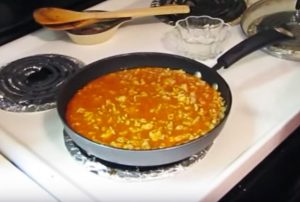This one of those dishes where Puerto Ricans on the mainland U. S. took a native dish and changed it to suit their needs. On the island, this dish was prepared as pastelillos or meat pies. This entails the use of plantains leaves. A portion of cornmeal filling in placed on a leaf, which is then folded to give the meat pie its shape. The meat pie is then carefully removed from the plantain leaf and deep-fried, hopefully retaining its form. Nuyorican’s find this time consuming We’ve developed our own way of doing things. We shape the cornmeal mixture with the hands, or by using two spoons. Then we fry it.
Even with the Nuyorican method, this dish that takes time. This is not a quicky meal and, in our culture, it is served as an appetizer or a meal in itself. But the time it takes to make it is well worth the effort. Note that beef is used to stuff the cornmeal balls. If preferred, you can substitute ground chicken or turkey. I know some folks, on the high end, who stuff it with veal. Use whatever suits your taste.
This recipe calls for sofrito, that popular flavoring indigenous to criollo cooking. In Puerto Rican cuisine, sofrito is the standout. Think of garam masala in Indian cuisine or kimchi in Korean cooking. Sofrito serves the same purpose. Today you can find processed sofrito in specialty food stores or most supermarket and, honestly, it’s chemicalized crap. Your best bet is to make some at home. We have a recipe for it on my post of 11/08/10. If you can’t find the right ingredients in your area, here’s a quick recipe that will do in a pinch. It’s not the genuine stuff, but it’ll be close. In a blender or food processor, blend 1 tablespoon fresh chopped cilantro; 2 tablespoons fresh chopped parsley; 1 medium chopped green pepper; 1 clove garlic; 1 coarsely chopped medium onion; 3 sweet chili peppers (not the hit kind). This will make about ¾ cup . You can double or triple the recipe if desired. It should be stored in a closed tight jar in the refrigerator for 3 to 4 day, or in the freezer compartment indefinitely.
RELLENOS DE HARINA DE MAIZ
(Stuffed Cornmeal Balls)
Ingredients:
1 cup water
Salt to taste
2 tablespoons butter
2 cups yellow cornmeal
½ cup flour
¾ cup olive oil
2 tablespoons sofrito (see above)
1 cup lean ground beef (about ¼ pound)
2 tablespoons tomato sauce
½ teaspoon capers
Vegetable oil for frying
Instructions:
- Boil water in a small saucepan and add the salt and butter.
- Combine cornmeal and flour in a bowl. Add the boiling water, mixing well to form a soft dough. Set aside and let stand for 30 minutes.
- Meanwhile heat olive oil in a skillet or cast iron pan. Add sofrito and ground beef. Sauté over medium heat until meat loses its red color.
- Stir in tomato sauce and capers. Cover and simmer on low heat for 30 minutes, stirring occasionally to prevent sticking.
- For the final step, some folks like to shape the cornmeal using two spoons. That is, scooping out a spoonful of cornmeal mix, and smoothing out the mixture so that it’s level with the spoon. Then placing a teaspoon of beef filling atop the cornmeal. Lastly, covering filling with a tablespoon filled level with the cornmeal mix, and shaping the whole cornmeal ball into an oval. While doing this, always remember to keep your hands lightly wet.. Some cooks prefer to shape the cornmeal balls by hand. Use whatever technique works best for you.
- Deep fry in hot oil until golden.
Yield: About 8 stuffed cornmeal balls.

 The American Heritage Dictionary of the English Language describes cassava as a tropical American plant with a starchy root from which tapioca is derived. To us Latinos from the Caribbean, it’s yuka (yoo-ka). Yuka is most commonly served peeled and boiled with a bit of olive oil sprinkled on top. But it also yields a bitter or sweet starch known as manioc which is used in the making of farina and, of course, tapioca. For those interested in arcane terminology, manioc is a word of Tupian origin, attributed to the Tupis, a group of American Indian tribes living along the coast of Brazil and the Amazon River valley. To explorers from the Old World, this new food was a wonder.
The American Heritage Dictionary of the English Language describes cassava as a tropical American plant with a starchy root from which tapioca is derived. To us Latinos from the Caribbean, it’s yuka (yoo-ka). Yuka is most commonly served peeled and boiled with a bit of olive oil sprinkled on top. But it also yields a bitter or sweet starch known as manioc which is used in the making of farina and, of course, tapioca. For those interested in arcane terminology, manioc is a word of Tupian origin, attributed to the Tupis, a group of American Indian tribes living along the coast of Brazil and the Amazon River valley. To explorers from the Old World, this new food was a wonder.






